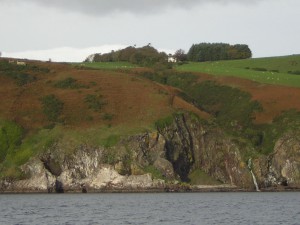Ainmean-Àite 4:
na Gàidheal – Creideamh is Caistealan
Creideamh
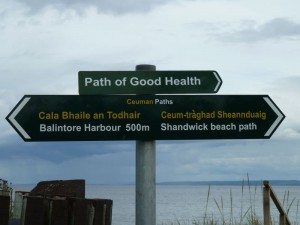 Ged a dh’fhaodas a bhith fianais air ‘Draoidhean’ anns an sgìre anns na h-ainmean ‘Port an Druidh’, agus ‘Cadha Port an Druidh’ air Beinn Neig, ‘s dòcha ceangailte ris na Decantae (c. 120 BC), chan eil eòlas cinnteach againn dè na h-ainmean-àite a dh’fhaodas a dhol air ais chun an àm ron chreideamh Chrìosdail. Mar a chunnaic sinn, ‘s dòcha gur e am facal Gàidhlig ‘righ’ a tha air cùl ‘druidh’. Tha mòran tobraichean ann, gu h-àraidh ann am paraiste Neig, mar Tobar na Slàinte, fhathast ann an-diugh fhèin, air a’ chladach faisg air Port an Druidh, agus Tobar Chormaig, faisg air an tuathanas aig Seannduig. Tha làrach Tobar na h-Iù faisg air ‘an t-sìthean’ (Dùn Rath-riachaidh, Rarichie), agus bha feartan draoidheil leigheis aice a rèir coltais. Bha agus tha saobh-chràbhadh riamh ann anns na bailtean-iasgaich, taobh ri taobh le creideamh Crìosdail làidir, ‘s dòcha air fhagail aca bho àm nan Ceilteach na bu thràithe. Bha an saoghal ro chruaidh ‘s gum biodh iad a’ diùltadh cuideachadh de sheòrsa sam bith.
Ged a dh’fhaodas a bhith fianais air ‘Draoidhean’ anns an sgìre anns na h-ainmean ‘Port an Druidh’, agus ‘Cadha Port an Druidh’ air Beinn Neig, ‘s dòcha ceangailte ris na Decantae (c. 120 BC), chan eil eòlas cinnteach againn dè na h-ainmean-àite a dh’fhaodas a dhol air ais chun an àm ron chreideamh Chrìosdail. Mar a chunnaic sinn, ‘s dòcha gur e am facal Gàidhlig ‘righ’ a tha air cùl ‘druidh’. Tha mòran tobraichean ann, gu h-àraidh ann am paraiste Neig, mar Tobar na Slàinte, fhathast ann an-diugh fhèin, air a’ chladach faisg air Port an Druidh, agus Tobar Chormaig, faisg air an tuathanas aig Seannduig. Tha làrach Tobar na h-Iù faisg air ‘an t-sìthean’ (Dùn Rath-riachaidh, Rarichie), agus bha feartan draoidheil leigheis aice a rèir coltais. Bha agus tha saobh-chràbhadh riamh ann anns na bailtean-iasgaich, taobh ri taobh le creideamh Crìosdail làidir, ‘s dòcha air fhagail aca bho àm nan Ceilteach na bu thràithe. Bha an saoghal ro chruaidh ‘s gum biodh iad a’ diùltadh cuideachadh de sheòrsa sam bith.
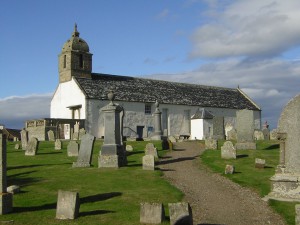 Ach ‘s ann bhon eaglais Chrìosdail a thàinig an àireamh a bu mhotha de na h-ainmean anns an roinn seo. Bho àm Chaluim Chille co-dhiù bha eaglaisean agus manaich ann, gu h-àraidh aig Port MoCholmaig, (Port Naomh Colmag / St Colman) far an robh manachainn Chruithneach. As dèidh sin thàinig Manachainn Rois. ‘S e ‘Feàrn’ an t-ainm a bha oirre roimhe, oir dh’imrich a’ mhanachainn bho Fheàrn, faisg air Eadardan, agus ‘s e Fearn an t-ainm a chùm i sa Bheurla. ‘S e Port an Ab an seann ainm ionadail air Baile an Todhair. Thug Templecroft faisg air Bindal ainm bho Theampall Earach, uamh anns na creagan far an robh (a rèir beul-aithris) seirbheisean-eaglais de sheòrsa air choreigin.
Ach ‘s ann bhon eaglais Chrìosdail a thàinig an àireamh a bu mhotha de na h-ainmean anns an roinn seo. Bho àm Chaluim Chille co-dhiù bha eaglaisean agus manaich ann, gu h-àraidh aig Port MoCholmaig, (Port Naomh Colmag / St Colman) far an robh manachainn Chruithneach. As dèidh sin thàinig Manachainn Rois. ‘S e ‘Feàrn’ an t-ainm a bha oirre roimhe, oir dh’imrich a’ mhanachainn bho Fheàrn, faisg air Eadardan, agus ‘s e Fearn an t-ainm a chùm i sa Bheurla. ‘S e Port an Ab an seann ainm ionadail air Baile an Todhair. Thug Templecroft faisg air Bindal ainm bho Theampall Earach, uamh anns na creagan far an robh (a rèir beul-aithris) seirbheisean-eaglais de sheòrsa air choreigin.
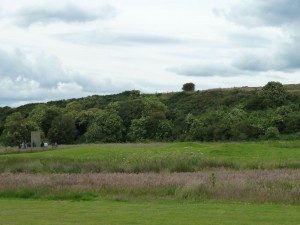 Aig Baile a’ Chnuic tha làrach Caibeal Mhoire ann le ‘Creag na Baintighearna’ air an tràigh, agus ‘Bàrd Mhoire’ (agus Lady Street sa bhaile fhèin, ainm a thàinig le cinnt bho na linntean ron Eaglais Chlèirich.) Tha tobraichean ann an sin cuideachd, m.e. am fear faisg air an allt (is e ga chleachdadh fhathast nuair a bha mise òg), agus fear eile faisg air làrach cladh a’ chaibeil, Lady’s Well, far an deach clann gun bhaisteadh a thiodhlacadh. Thachair an aon rud ri taobh Clach a’ Charraidh, ainm ionadail air Clach Sheannduaig, agus tha e coltach gun deach an fheadhainn a thiodhlachadh an sin cuideachd a dh’eug den cholera. Do na truaghain sin, bha na tursachan Cruithneach iongantach seo, leis na samhlaidhean Crìosdail orra, nan ‘carragh’ dhà-rìribh.
Aig Baile a’ Chnuic tha làrach Caibeal Mhoire ann le ‘Creag na Baintighearna’ air an tràigh, agus ‘Bàrd Mhoire’ (agus Lady Street sa bhaile fhèin, ainm a thàinig le cinnt bho na linntean ron Eaglais Chlèirich.) Tha tobraichean ann an sin cuideachd, m.e. am fear faisg air an allt (is e ga chleachdadh fhathast nuair a bha mise òg), agus fear eile faisg air làrach cladh a’ chaibeil, Lady’s Well, far an deach clann gun bhaisteadh a thiodhlacadh. Thachair an aon rud ri taobh Clach a’ Charraidh, ainm ionadail air Clach Sheannduaig, agus tha e coltach gun deach an fheadhainn a thiodhlachadh an sin cuideachd a dh’eug den cholera. Do na truaghain sin, bha na tursachan Cruithneach iongantach seo, leis na samhlaidhean Crìosdail orra, nan ‘carragh’ dhà-rìribh.
Tha pàirt de Phort MoCholmaig air a bheil Gaza mar ainm; ‘s e ainm bìoballach a th’ ann, agus tha dà mhìneachadh ionadail ann, a rèir Watson: airson ‘s gun robh e mar fhàsach leis a’ ghainmheach a bh’ ann, no air sgàth ‘s gun robh “muinntir Ghaza” (‘Philistines’) aig a’ mhinistear air na daoine an àite leis nach biodh iad a’ dol dhan eaglais tric gu leòr!
Caistealan is Daighnichean
B’ fhìach riamh fearann torrach Mhachair Rois a dhìon, agus bho na linntean a bu thràithe tha iomadh ràth, dùn agus caisteal ann, no tha co-dhiù na h-ainmean air fhàgail againn.
ràth daighneach cruinn (Ceilteach no na bu thràithe)
Rhynie ràthan (tha dà ann, Rhynie agus Meikle Rhynie)
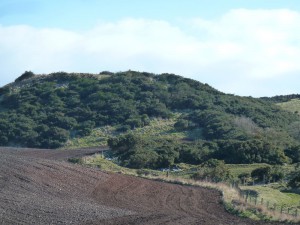 Rarichie ràth-riachaidh (air sgàth nan drisean no a’ chonaisg a th’ ann fhathast?) – làrach daignich Chruithnich, air an robh fhathast ‘Danish Fort’ air a’ mhapa OS 1911. Bha muinntir a’ bhaile riamh glè dheònach creidsinn gum b’ ann bho na Lochlannaich a bha gach leac is dùn, fiù ‘s na leacan Cruithneach fhèin (chuala mi fhìn an sgeul gur ann an sin ‘where the three king’s sons were buried’ nuair a bha mi òg), agus bha clann leithid mo mhàthar an-còmhnaidh a’ cladhach airson ‘Viking treasure’ anns na dùin agus fiù ‘s an làrach Caibeal Mhoire.
Rarichie ràth-riachaidh (air sgàth nan drisean no a’ chonaisg a th’ ann fhathast?) – làrach daignich Chruithnich, air an robh fhathast ‘Danish Fort’ air a’ mhapa OS 1911. Bha muinntir a’ bhaile riamh glè dheònach creidsinn gum b’ ann bho na Lochlannaich a bha gach leac is dùn, fiù ‘s na leacan Cruithneach fhèin (chuala mi fhìn an sgeul gur ann an sin ‘where the three king’s sons were buried’ nuair a bha mi òg), agus bha clann leithid mo mhàthar an-còmhnaidh a’ cladhach airson ‘Viking treasure’ anns na dùin agus fiù ‘s an làrach Caibeal Mhoire.
Ach tha sinn an dòchas gum bi fios a bharrachd againn mu na làraichean Cruithneach seo a dh’aithghearr, leis gum bi planaichean arc-eòlach mòra air an son. http://www.scotsman.com/lifestyle/heritage/new-excavations-to-find-lost-pictish-kingdom-1-2925006
dùn Dunskaith G. Dùn Sgàth, làrach caisteal Rìgh Uilleim (‘an Leòmhann’)
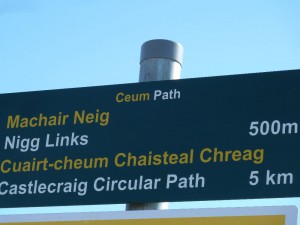 caisteal Castlecraig G. Caisteal Crag (sic) – ceangailte ri Dunskaith, agus làraich no tobhtaichean chaisteil eile air feadh na sgìre, m.e. Caisteal Chathabol, Caisteal Bail’ an Lòin (Ballone) – ‘s e ‘Cast.Terbart’ a bha aig Pont air (c.1590).
caisteal Castlecraig G. Caisteal Crag (sic) – ceangailte ri Dunskaith, agus làraich no tobhtaichean chaisteil eile air feadh na sgìre, m.e. Caisteal Chathabol, Caisteal Bail’ an Lòin (Ballone) – ‘s e ‘Cast.Terbart’ a bha aig Pont air (c.1590).
Tha fiù ‘s Blàr a’ Chath ann, faisg air Rubha Thairbeirt.
Bha sinn a’ coimhead air mòran seòrsaichean eadar-dhealaichte de dh’ainmean-àite Gàidhlig ann am Machair Rois – bailtean is feartan na tìre, an oirthir, an eaglais agus na daignichean. Tha iomadach ainm-àite Gàidhlig eile anns an sgìre, ach b’ e seo taghadh de na raointean as cudromaiche. An ath thuras thig cuairt air na h-ainmean-àite Beurla agus Beurla Ghallda.
*******************************************************************************
Placenames 4
– the Gaels : Faith and Fortresses
Faith
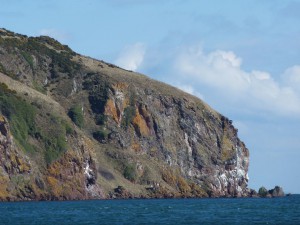 Though there’s a faint chance that we have evidence of Druids in the area in the names ‘Port an Druidh’ and ‘Cadha (pass, ravine) Port an Druidh’ on Nigg Hill, maybe connected to the ancient Decantae tribe (c. 120 BC), we don’t have any names that go back with certainty to pre-Christian times. As we saw, ‘an druidh’ is probably a corruption of the Gaelic ‘an righ’, the king.
Though there’s a faint chance that we have evidence of Druids in the area in the names ‘Port an Druidh’ and ‘Cadha (pass, ravine) Port an Druidh’ on Nigg Hill, maybe connected to the ancient Decantae tribe (c. 120 BC), we don’t have any names that go back with certainty to pre-Christian times. As we saw, ‘an druidh’ is probably a corruption of the Gaelic ‘an righ’, the king.
There are many wells, especially in the parish of Nigg, such as the Well of Health (Tobar na Slàinte) by the shore near Port an Druidh, and St Cormac’s Well (Tobar Chormaig) near Shandwick farm. The site of the Well of the Yew (Tobar na h-Iù) is near the ‘fairy hill’ of Rarichie (Dùn Rathriachaidh), and it allegedly had magical healing properties. Superstition, or acceptance of the supernatural, existed and still does in the fishing communities, side by side with a strong Christian faith, probably passed down from earlier Celtic times. In dangerous professions like fishing, no one turned their nose up at the ‘belt and braces’ approach.
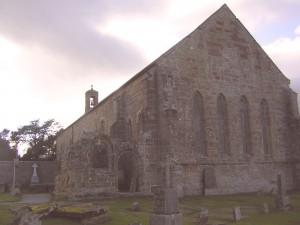 But it’s from the Christian church that the majority of faith-related place-names come. From the time of St Columba at least there were churches and monks here, especially in Port MoCholmaig (St Colman’s Port – Portmahomack), where there was a Pictish monastery. Later there followed Manachainn Rois , the Monastery of Ross. Its previous name had been Feàrn (alder tree) as the monastery moved to Easter Ross from Feàrn, near Edderton, and Fearn is the name the Abbey has kept today in English. Balintore’s old local name was Port an Ab, the Abbot’s port. Templecroft, near Bindal, took its name from Teampall Earach, Easter Temple, a cave in the cliffs where (tradition says) church-services of some kind were held.
But it’s from the Christian church that the majority of faith-related place-names come. From the time of St Columba at least there were churches and monks here, especially in Port MoCholmaig (St Colman’s Port – Portmahomack), where there was a Pictish monastery. Later there followed Manachainn Rois , the Monastery of Ross. Its previous name had been Feàrn (alder tree) as the monastery moved to Easter Ross from Feàrn, near Edderton, and Fearn is the name the Abbey has kept today in English. Balintore’s old local name was Port an Ab, the Abbot’s port. Templecroft, near Bindal, took its name from Teampall Earach, Easter Temple, a cave in the cliffs where (tradition says) church-services of some kind were held.
Near Hilton there’s the site of Caibeal Mhoire, St Mary’s Chapel, with the rock called ‘Creag na Baintighearna’, Our Lady’s Rock, on the beach, 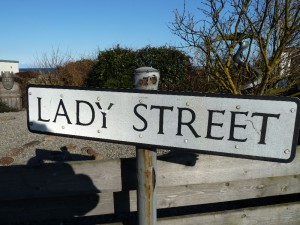 and ‘Bàrd Mhoire’, St Mary’s meadow, and Lady Street in the village itself, a name that has certainly existed since pre-Presbyterian centuries. There are wells there too, near the burn (that one was still being used for domestic water needs when I was young), and another near the chapel cemetary site, Lady’s Well, where unbaptised children were buried. The same thing happened beside Clach a’ Charraidh (Monument Stone), the local name for the Shandwick Stone, and it seems likely that those who died of cholera were also buried there. For these poor souls, the amazing Pictish stones with the Christian symbols on them were monuments, indeed.
and ‘Bàrd Mhoire’, St Mary’s meadow, and Lady Street in the village itself, a name that has certainly existed since pre-Presbyterian centuries. There are wells there too, near the burn (that one was still being used for domestic water needs when I was young), and another near the chapel cemetary site, Lady’s Well, where unbaptised children were buried. The same thing happened beside Clach a’ Charraidh (Monument Stone), the local name for the Shandwick Stone, and it seems likely that those who died of cholera were also buried there. For these poor souls, the amazing Pictish stones with the Christian symbols on them were monuments, indeed.
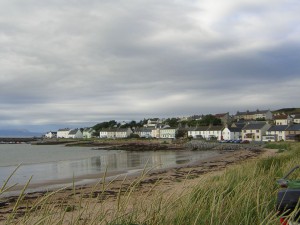 There’s a part of Portmahomack called Gaza; it’s a Biblical name, and there are two local explanations according to Watson. Either it was because it was like the desert of Gaza with all the sand, or because the minister referred to the residents as ‘muinntir Gaza’ (people of Gaza, i.e. ‘Philistines’) as they were not in the habit of attending church often enough!
There’s a part of Portmahomack called Gaza; it’s a Biblical name, and there are two local explanations according to Watson. Either it was because it was like the desert of Gaza with all the sand, or because the minister referred to the residents as ‘muinntir Gaza’ (people of Gaza, i.e. ‘Philistines’) as they were not in the habit of attending church often enough!
Fortresses
The fertile land of Easter Ross was always worth defending, and from the earliest centuries there are many forts, duns and castles, or at least their names, which have come down to us.
ràth – a Celtic or earlier word for a fortified circular enclosure or mound.
> Rhynie = ràthan + i, place of the mounds (there are two, Rhynie and Meikle Rhynie)
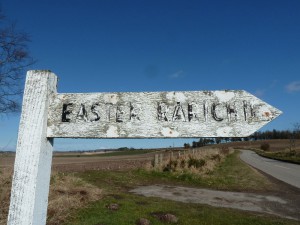 > Rarichie – ràth-riachaidh – ‘fort of the scratching’ (possibly because of the brambles which are still there?). A Pictish fort site, which as late as 1911 was still being called a ‘Danish Fort’ on the OS map. Local people were always very willing to believe that it was the Vikings who were behind every standing stone and mound, even the Pictish stones (I remember myself being told the story ‘that’s where the three king’s sons were buried’ when I was young), and children (like my mother) were always digging for ‘Viking treasure’ below any mound, even on the chapel site.
> Rarichie – ràth-riachaidh – ‘fort of the scratching’ (possibly because of the brambles which are still there?). A Pictish fort site, which as late as 1911 was still being called a ‘Danish Fort’ on the OS map. Local people were always very willing to believe that it was the Vikings who were behind every standing stone and mound, even the Pictish stones (I remember myself being told the story ‘that’s where the three king’s sons were buried’ when I was young), and children (like my mother) were always digging for ‘Viking treasure’ below any mound, even on the chapel site.
But we’re hoping to get a lot more information on the Pictish sites here soon with the grand archeological plans that are afoot now: http://www.scotsman.com/lifestyle/heritage/new-excavations-to-find-lost-pictish-kingdom-1-2925006
dùn – fort
> Dunskaith– Dùn Sgàth, ‘protected fort’, site of a castle built by William the Lion
> Castlecraig – Caisteal Creag / Creag a’ Chaisteil – connected to Dunskaith;
and the sites of other castle ruins around the area, e.g. Cadboll Castle (Caisteal Chatabol), Ballone (Bail’ an Lòin) – which was called ‘Cast.Tarbat’ on Pont’s map of c.1590.
There’s even the name ‘Battlefield‘, ‘Blar a’ Chath’, near Tarbat Ness.
In these last 3 issues we’ve been looking at the Gaelic names that dominate the others around the Seaboard under three main headings – settlements and landscape, the coast, faith and fortresses. In the last installment it’ll be the turn of Scots and English names.
